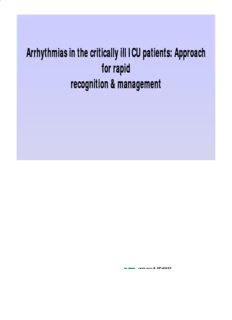
Arrhythmias in the critically ill ICU patients PDF
Preview Arrhythmias in the critically ill ICU patients
AAAArrrrrrrrhhhhyyyytttthhhhmmmmiiiiaaaassss iiiinnnn tttthhhheeee ccccrrrriiiittttiiiiccccaaaallllllllyyyy iiiillllllll IIIICCCCUUUU ppppaaaattttiiiieeeennnnttttssss:::: AAAApppppppprrrrooooaaaacccchhhh ffoorr rraappiidd rrrreeeeccccooooggggnnnniiiittttiiiioooonnnn &&&& mmmmaaaannnnaaaaggggeeeemmmmeeeennnntttt William R. Lewis, MD OObbjjeeccttiivveess •• BBee aabbllee ttoo iiddeennttiiffyy aanndd mmaannaaggee:: – Atrial fibrillation with a rapid ventricular response – AAttrriiaall fflluutttteerr – Supraventricular tachycardia – VVenttriicullar ttachhycarddiia – Torsade de pointe – SSiinus bbraddycarddiia – Complete AV block AAttrriiaall ffiibbrriillllaattiioonn • The most common aarrrrhhyytthhmmiiaa iinn hospitalized patients • AAssssoocciiaatteedd wwiitthh hypotension due to ddeeccrreeaasseedd ddiiaassttoolliicc filling time • Rate controll in ICCU patients may be ddiiffffiicullt as many drugs cause hhypotensiion RReeccooggnniittiioonn • Rapid, irregular and sudden onset • Chhaotic bbaselline • May appear regular at very rapid rates TTrreeaattmmeenntt • Rate control – IInnttrraavveennoouuss ddiillttiiaazzeemm – Intravenous beta blockers – DDiiggooxxiinn:: AAcchhiieevveess rraattee ccoonnttrrooll sslloowwllyy aanndd iiss lleessss effective in ICU patients and thyrotoxicosis •• AAccuuttee ccoonnvveerrssiioonn ttoo ssiinnuuss rrhhyytthhmm – Unstable patients (hypotension, chest pain, acute heart ffaaiilluurree)) – Inability to control rate – DDeessiirree ttoo aavvooiidd aannttiiccooaagguullaattiioonn RRaattee ccoonnttrrooll mmeeddiiccaattiioonnss • IV and oral Diltiazem • IV and oral Verapamil • IIVV aanndd oorraall MMeettoopprroollooll • IIVV EEssmmoollooll • IV and oral Amiodarone IInnttrraavveennoouuss ddiillttiiaazzeemm • Bolus, 0.25 mg/kg IV • IIff iinnaaddeeqquuaattee, sseeccoonndd bboolluuss, 0.35 mg/kg • Inffusion rate: 5 mg//hh. • The infusion rate may be increased in 5 mg/h increments up to 15 mg/h • The infusion may be mmaaiinnttaaiinneedd ffoorr uupp ttoo 2244 hours IInnttrraavveennoouuss MMeettoopprroollooll vveerrssuuss DDiillttiiaazzeemm Atrial Fibrillation Rate: >120/min Systolic BP: > 95 mm Hg Metoprolol, 0.15 Diltiazem, 0.25 mg/kg IV mg/kg IV ((maximum 10 mgg)) ((maximum 25 mgg)) Success: HR <100 BPM DDiillttiiaazzeemm:: 9900%% Metoprolol: 80% Demircan, et al. Emerg Med J, 2005 DDiillttiiaazzeemm vveerrssuuss eessmmoollooll Atrial fibrillation after CABG or valve, HR > 100 BPM & hheemmooddyynnaammiiccaallllyy ssttaabbllee Esmolol Diltiazem Bolus: 500 µg/kg Bolus: .25-.35 mg/kg Drip: 25-50 µg/kg/min Drip: 5-15 mg/hr Titrate up by 25-50 µg/kg/min/10 minutes At 1 hour 50 4400 EEsmolloll •At 12 hours, rate control was achieved: 40 Diltiazem •Diltiazem: 100% t 26.7 n30 •EEssmmoollooll:: 4400%% e 2200 cc r •At 24 hours, sinus rhythm was achieved: e20 P •Diltiazem: 67% 6.7 10 •Esmolol: 80% 0 Conversion to SR Rate < 90 bpm Mooss, et al. Am Heart J, 2000 AAccuuttee ccoonnvveerrssiioonn ooppttiioonnss • DC cardioversion – AAddvvaannttaaggeess:: NNeeaarrllyy 110000%% ssuucccceessssffuull – Disadvantages: Requires sedation • IIbbuttiilliidde – Advantage: Intravenous – Disadvantage: Less effective, risk of torsade de pointe in 4.1% • AAmiioddarone – Conversion to NSR achieved in 83% of patients with recentt onsett AAFF ((<1122 hhrs)) vs 4444%% off pllacebbo ttreattedd patients (Cybulski, et al. Clin Card, 2008)
Description: